3.7E: Exercises
- Last updated
- Sep 14, 2021
- Save as PDF
- Page ID
- 84758
( \newcommand{\kernel}{\mathrm{null}\,}\)
In exercises 1 - 4, determine whether the statements are true or false.
1. If surface S is given by {(x,y,z):0≤x≤1,0≤y≤1,z=10}, then ∬Sf(x,y,z)dS=∫10∫10f(x,y,10)dxdy.
- Answer
- True
2. If surface S is given by {(x,y,z):0≤x≤1,0≤y≤1,z=x}, then ∬Sf(x,y,z)dS=∫10∫10f(x,y,x)dxdy.
3. Surface ⇀r=⟨vcosu,vsinu,v2⟩, for 0≤u≤π,0≤v≤2 is the same surface ⇀r=⟨√vcos2u,√vsin2u,v⟩, for 0≤u≤π2,0≤v≤4.
- Answer
- True
4. Given the standard parameterization of a sphere, normal vectors ⇀tu×⇀tv are outward normal vectors.
In exercises 5 - 10, find parametric descriptions for the following surfaces.
5. Plane 3x−2y+z=2
- Answer
- ⇀r(u,v)=⟨u,v,2−3u+2v⟩ for −∞≤u<∞ and −∞≤v<∞.
6. Paraboloid z=x2+y2, for 0≤z≤9.
7. Plane 2x−4y+3z=16
- Answer
- ⇀r(u,v)=⟨u,v,13(16−2u+4v)⟩ for |u|<∞ and |v|<∞.
8. The frustum of cone z2=x2+y2, for 2≤z≤8
9. The portion of cylinder x2+y2=9 in the first octant, for 0≤z≤3
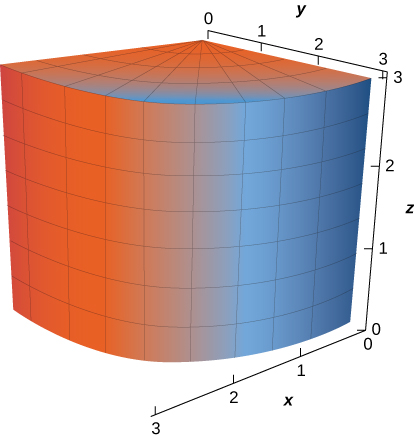
- Answer
- ⇀r(u,v)=⟨3cosu,3sinu,v⟩ for 0≤u≤π2,0≤v≤3
10. A cone with base radius r and height h, where r and h are positive constants.
For exercises 11 - 12, use a computer algebra system to approximate the area of the following surfaces using a parametric description of the surface.
11. [T] Half cylinder {(r,θ,z):r=4,0≤θ≤π,0≤z≤7}
- Answer
- A=87.9646
12. [T] Plane z=10−z−y above square |x|≤2,|y|≤2
In exercises 13 - 15, let S be the hemisphere x2+y2+z2=4, with z≥0, and evaluate each surface integral, in the counterclockwise direction.
13. ∬SzdS
- Answer
- ∬SzdS=8π
14. ∬S(x−2y)dS
15. ∬S(x2+y2)dS
- Answer
- ∬S(x2+y2)dS=16π
In exercises 16 - 18, evaluate ∫∫S⇀F⋅⇀NdS for vector field ⇀F where ⇀N is an outward normal vector to surface S.
16. ⇀F(x,y,z)=xˆi+2yˆj=3zˆk, and S is that part of plane 15x−12y+3z=6 that lies above unit square 0≤x≤1,0≤y≤1.
17. ⇀F(x,y)=xˆi+yˆj, and S is hemisphere z=√1−x2−y2.
- Answer
- ∬S⇀F⋅⇀NdS=4π3
18. ⇀F(x,y,z)=x2ˆi+y2ˆj+z2ˆk, and S is the portion of plane z=y+1 that lies inside cylinder x2+y2=1.
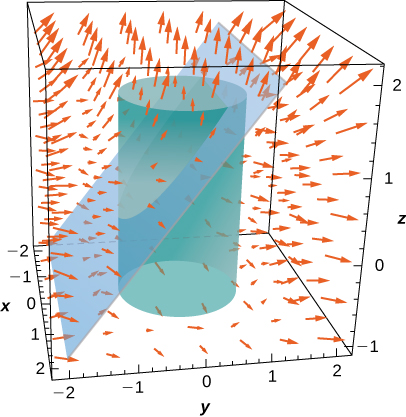
In exercises 19 - 20, approximate the mass of the homogeneous lamina that has the shape of given surface S. Round to four decimal places.
19. [T] S is surface z=4−x−2y, with z≥0,x≥0,y≥0;ξ=x.
- Answer
- m≈13.0639
20. [T] S is surface z=x2+y2, with z≤1;ξ=z.
21. [T] S is surface x2+y2+x2=5, with z≥1;ξ=θ2.
- Answer
- m≈228.5313
22. Evaluate ∬S(y2zˆi+y3ˆj+xzˆk)⋅dS, where S is the surface of cube −1≤x≤1,−1≤y≤1, and 0≤z≤2 in a counterclockwise direction.
23. Evaluate surface integral ∬SgdS, where g(x,y,z)=xz+2x2−3xy and S is the portion of plane 2x−3y+z=6 that lies over unit square R:0≤x≤1,0≤y≤1.
- Answer
- ∬SgdS=3√4
24. Evaluate ∬S(x+y+z)dS, where S is the surface defined parametrically by ⇀R(u,v)=(2u+v)ˆi+(u−2v)ˆj+(u+3v)ˆk for 0≤u≤1, and 0≤v≤2.
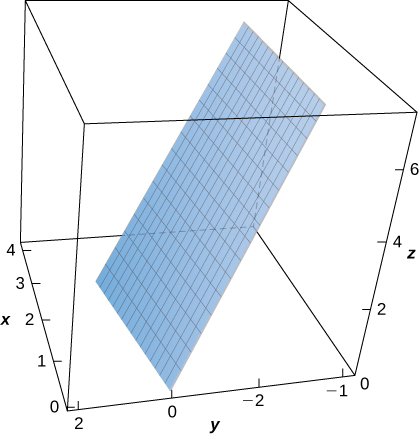
25. [T] Evaluate ∬S(x−y2+z)dS, where S is the surface defined parametrically by ⇀R(u,v)=u2ˆi+vˆj+uˆk for 0≤u≤1,0≤v≤1.
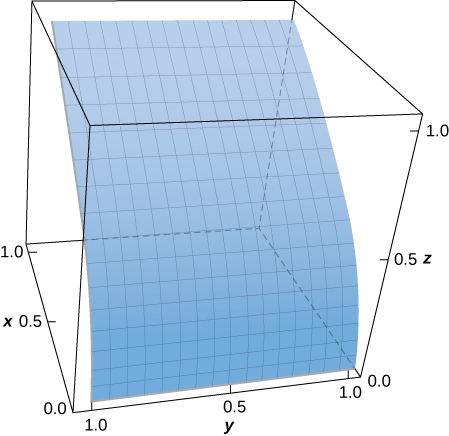
- Answer
- ∬S(x2+y−z)dS≈0.9617
26. [T] Evaluate where S is the surface defined by ⇀R(u,v)=uˆi−u2ˆj+vˆk,0≤u≤2,0≤v≤1 for 0≤u≤1,0≤v≤2.
27. Evaluate ∬S(x2+y2)dS, where S is the surface bounded above hemisphere z=√1−x2−y2, and below by plane z=0.
- Answer
- ∬S(x2+y2)dS=4π3
28. Evaluate ∬S(x2+y2+z2)dS, where S is the portion of plane that lies inside cylinder x2+y2=1.
29. [T] Evaluate ∬Sx2zdS, where S is the portion of cone z2=x2+y2 that lies between planes z=1 and z=4.
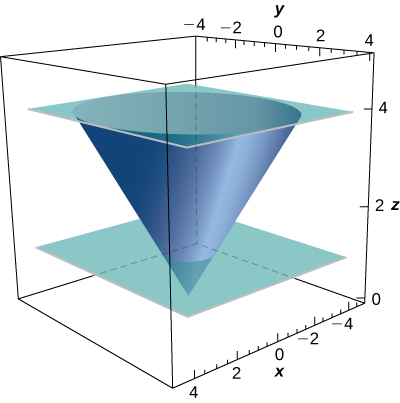
- Answer
- div⇀F=a+b
∬Sx2zdS=1023√2π5
30. [T] Evaluate ∬SxzydS, where S is the portion of cylinder x=y2 that lies in the first octant between planes z=0,z=5, and y=4.
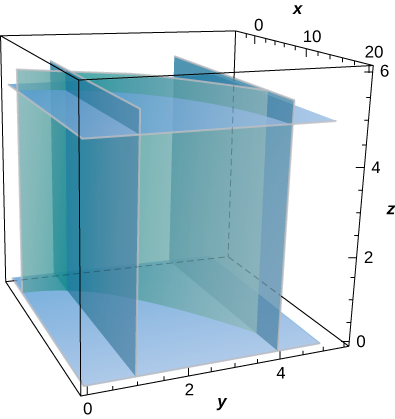
31. [T] Evaluate ∬S(z+y)dS, where S is the part of the graph of z=√1−x2 in the first octant between the xy-plane and plane y=3.
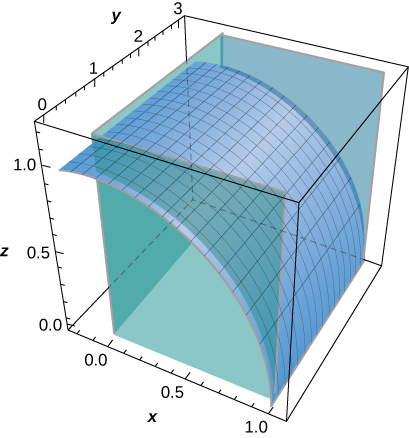
- Answer
- ∬S(z+y)dS≈10.1
32. Evaluate ∬SxyzdS if S is the part of plane z=x+y that lies over the triangular region in the xy-plane with vertices (0, 0, 0), (1, 0, 0), and (0, 2, 0).
33. Find the mass of a lamina of density ξ(x,y,z)=z in the shape of hemisphere z=(a2−x2−y2)1/2.
- Answer
- m=πa3
34. Compute ∫∫S⇀F⋅⇀NdS, where ⇀F(x,y,z)=xˆi−5yˆj+4zˆk and ⇀N is an outward normal vector S, where S is the union of two squares S1 : x=0,0≤y≤1,0≤z≤1 and S2:x=0,0≤x≤1,0≤y≤1.
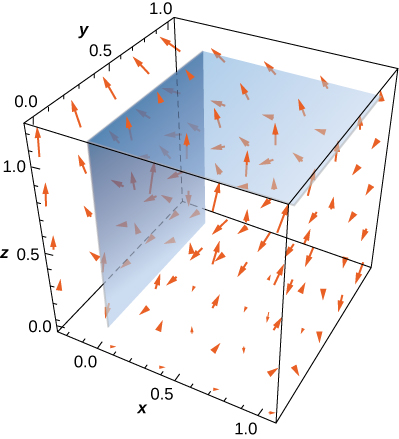
35. Compute ∫∫S⇀F⋅⇀NdS, where ⇀F(x,y,z)=xyˆi+zˆj+(x+y)ˆk and ⇀N is an outward normal vector S, where S is the triangular region cut off from plane x+y+z=1 by the positive coordinate axes.
- Answer
- ∬S⇀F⋅⇀NdS=1324
36. Compute ∫∫S⇀F⋅⇀NdS, where ⇀F(x,y,z)=2yzˆi+(tan−1xz)ˆj+exyˆk and ⇀N is an outward normal vector S, where S is the surface of sphere x2+y2+z2=1.
37. Compute ∫∫S⇀F⋅⇀NdS, where ⇀F(x,y,z)=xyzˆi+xyzˆj+xyzˆk and ⇀N is an outward normal vector S, where S is the surface of the five faces of the unit cube 0≤x≤1,0≤y≤1,0≤z≤1 missing z=0.
- Answer
- ∬S⇀F⋅⇀NdS=34
For exercises 38 - 39, express the surface integral as an iterated double integral by using a projection on S on the yz-plane.
38. ∬Sxy2z3dS; S is the first-octant portion of plane 2x+3y+4z=12.
39. ∬S(x2−2y+z)dS; S is the portion of the graph of 4x+y=8 bounded by the coordinate planes and plane z=6.
- Answer
- ∫80∫60(4−3y+116y2+z)(14√17)dzdy
For exercises 40 - 41, express the surface integral as an iterated double integral by using a projection on S on the xz-plane.
40. ∬Sxy2z3dS; S is the first-octant portion of plane 2x+3y+4z=12.
41. ∬S(x2−2y+z)dS; is the portion of the graph of 4x+y=8 bounded by the coordinate planes and plane z=6.
- Answer
- ∫20∫60[x2−2(8−4x)+z]√17dzdx
42. Evaluate surface integral ∬SyzdS, where S is the first-octant part of plane x+y+z=λ, where λ is a positive constant.
43. Evaluate surface integral ∬S(x2z+y2z)dS, where S is hemisphere x2+y2+z2=a2,z≥0.
- Answer
- ∬S(x2z+y2z)dS=πa52
44. Evaluate surface integral ∬SzdA, where S is surface z=√x2+y2,0≤z≤2.
45. Evaluate surface integral ∬Sx2yzdS, where S is the part of plane z=1+2x+3y that lies above rectangle 0≤x≤3 and 0≤y≤2.
- Answer
- ∬Sx2yzdS=171√14
46. Evaluate surface integral ∬SyzdS, where S is plane x+y+z=1 that lies in the first octant.
47. Evaluate surface integral ∬SyzdS, where S is the part of plane z=y+3 that lies inside cylinder x2+y2=1.
- Answer
- ∬SyzdS=√2π4
For exercises 48 - 50, use geometric reasoning to evaluate the given surface integrals.
48. ∬S√x2+y2+z2dS, where S is surface x2+y2+z2=4,z≥0
49. ∬S(xˆi+yˆj)⋅dS, where S is surface x2+y2=4,1≤z≤3, oriented with unit normal vectors pointing outward
- Answer
- ∬S(xˆi+yˆj)⋅dS=16π
50. ∬S(zˆk)⋅dS, where S is disc x2+y2≤9 on plane z=4 oriented with unit normal vectors pointing upward
51. A lamina has the shape of a portion of sphere x2+y2+z2=a2 that lies within cone z=√x2+y2. Let S be the spherical shell centered at the origin with radius a, and let C be the right circular cone with a vertex at the origin and an axis of symmetry that coincides with the z-axis. Determine the mass of the lamina if δ(x,y,z)=x2y2z.
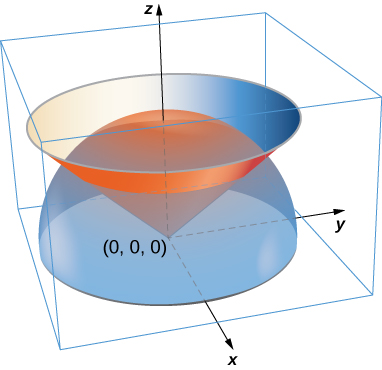
- Answer
- m=πa7192
52. A lamina has the shape of a portion of sphere x2+y2+z2=a2 that lies within cone z=√x2+y2. Let S be the spherical shell centered at the origin with radius a, and let C be the right circular cone with a vertex at the origin and an axis of symmetry that coincides with the z-axis. Suppose the vertex angle of the cone is ϕ0, with 0≤ϕ0<π2. Determine the mass of that portion of the shape enclosed in the intersection of S and C. Assume δ(x,y,z)=x2y2z.
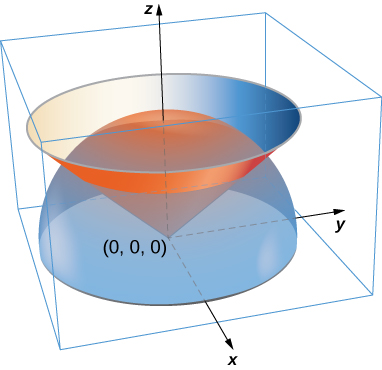
53. A paper cup has the shape of an inverted right circular cone of height 6 in. and radius of top 3 in. If the cup is full of water weighing 62.5lb/ft3, find the magnitude of the total force exerted by the water on the inside surface of the cup.
- Answer
- F≈4.57lb
For exercises 54 - 55, the heat flow vector field for conducting objects is ⇀F=−k⇀∇T, where T(x,y,z) is the temperature in the object and k>0 is a constant that depends on the material. Find the outward flux of ⇀F across the following surfaces S for the given temperature distributions and assume k=1.
54. T(x,y,z)=100e−x−y; S consists of the faces of cube |x|≤1,|y|≤1,|z|≤1.
55. T(x,y,z)=−ln(x2+y2+z2); S is sphere x2+y2+z2=a2.
- Answer
- 8πa
For exercises 56 - 57, consider the radial fields ⇀F=⟨x,y,z⟩(x2+y2+z2)p/2=r|r|p, where p is a real number. Let S consist of spheres A and B centered at the origin with radii 0<a<b. The total outward flux across S consists of the outward flux across the outer sphere B less the flux into S across inner sphere A.
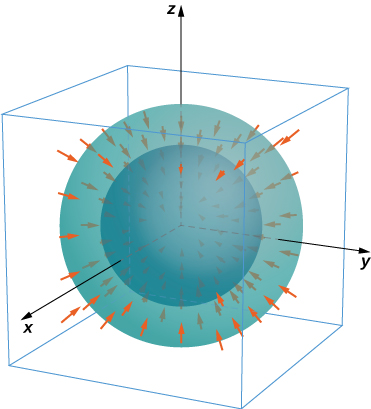
56. Find the total flux across S with p=0.
57. Show that for p=3 the flux across S is independent of a and b.
- Answer
- The net flux is zero.
Contributors
Gilbert Strang (MIT) and Edwin “Jed” Herman (Harvey Mudd) with many contributing authors. This content by OpenStax is licensed with a CC-BY-SA-NC 4.0 license. Download for free at http://cnx.org.


